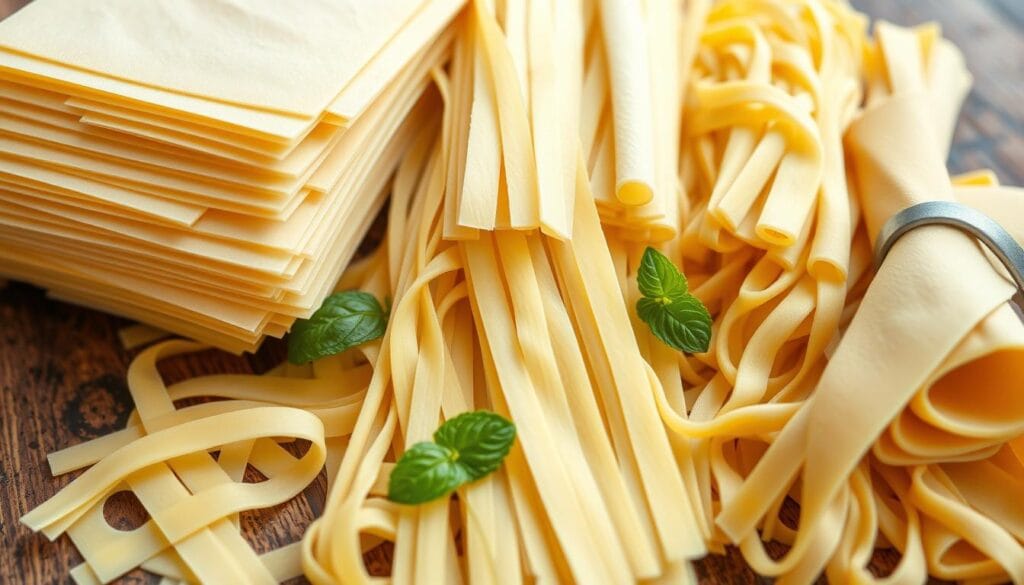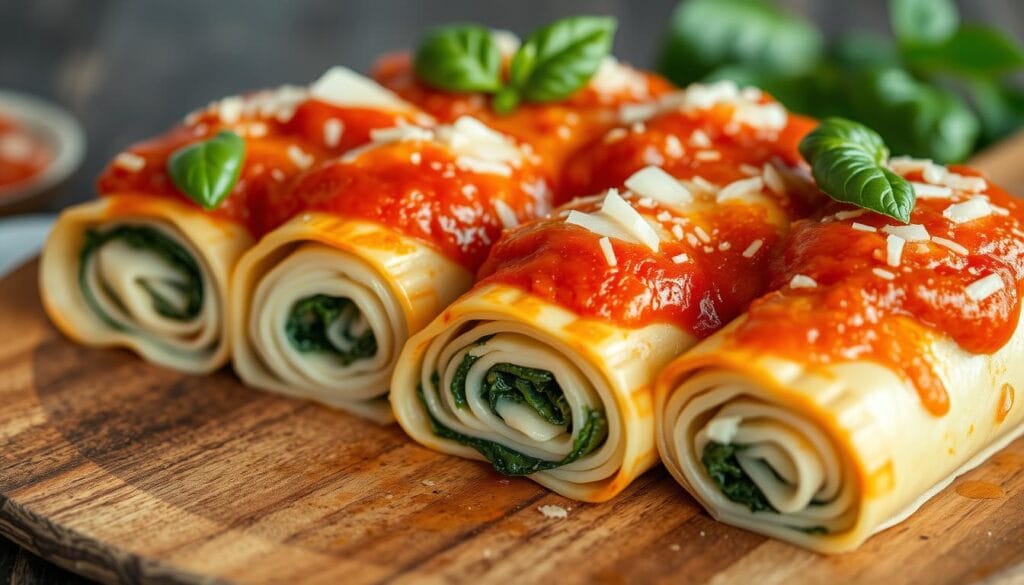As a passionate home cook, I’ve always loved layering lasagna noodles with rich sauces and cheeses. These wide, flat pasta sheets are key to making the beloved Italian dish we all love. But have you ever wondered about their history and the different types available?
In this guide, we’ll explore lasagna noodles in depth. We’ll look at their composition, types, and how to use them in your dishes. Whether you’re a lasagna expert or new to Italian cooking, this article will help you make better choices and improve your lasagna skills.
So, let’s start a flavorful journey. We’ll discover the secrets of these versatile pasta sheets that have delighted cooks for centuries.
Table of Contents
Understanding Traditional Lasagna Noodles
Lasagna is one of the oldest pasta dishes in Italian cuisine. It has a history that goes back centuries. The name “Lasagna” comes from a Latin word for a cooking pot, “lasanum.”
The modern lasagna noodles come from the province of Emilia-Romagna.
Composition and Basic Characteristics
Traditional lasagna noodles are made from durum wheat semolina flour and water. The dough is rolled out and cut into flat sheets or rectangles. These noodles can have different textures, like smooth, ridged, or wavy edges (known as “lasagna riccia”).
Different Types of Edges and Textures
- Smooth-edged lasagna noodles
- Lasagna riccia (wavy-edged noodles)
- Ridged noodles designed to better capture sauces and fillings
Standard Dimensions and Shapes
Lasagna noodles are wide and flat to create even layers. Their dimensions vary but fit snugly in a baking dish. Dried lasagna noodles are common, while fresh noodles are often homemade or found in specialty shops.
| Characteristic | Description |
|---|---|
| Composition | Durum wheat semolina flour and water |
| Texture | Smooth, ridged, or wavy (lasagna riccia) |
| Dimensions | Wide, flat shape to create even layers |
| Cooking Time | Dried noodles: 7-9 minutes |
Whether you’re making a classic Italian lasagna or a modern American version, knowing about traditional lasagna noodles is key. It’s essential for making the perfect layered pasta dish.
The Rich History and Origins of Lasagna Pasta
Lasagna, a favorite layered pasta dish, has a long history. It dates back to at least the Middle Ages. The first lasagna recipe was found in “The Book of Cookery” from the 14th century.
The name “lasagna” might come from Ancient Greece. It could be linked to “laganon” (flat pasta dough) or “lasana” (pot stand).
The modern version of lasagna comes from the Emilia-Romagna region of Italy. This area is famous for its layered pasta dishes, like lasagna. It’s a tradition that’s over 800 years old.
“Lasagna has been a staple of Italian cuisine for centuries, with its origins deeply rooted in the cultural heritage of the Emilia-Romagna region.”
Over time, lasagna has grown in popularity. It’s now loved all over Italy and the world. The dish’s evolution is tied to the introduction of durum wheat and the Industrial Revolution.
Today, lasagna is a beloved dish worldwide. It shows the rich history and cultural importance of this layered pasta dish.
Essential Ingredients in Lasagna Noodles
The heart of a great lasagna is its pasta sheets. At the core of these sheets is durum wheat semolina flour. This flour gives the pasta its unique texture and bite, essential for the Italian taste.
Durum Wheat Semolina Role
Durum wheat semolina makes lasagna noodles firm and al dente. This quality keeps the noodles intact during baking. It’s what makes a lasagna satisfying and complete.
Fresh vs Dried Ingredients
- Fresh lasagna noodles have eggs, adding richness and binding the ingredients.
- Dried noodles are made from durum wheat semolina and water, simpler and straightforward.
Quality Indicators to Look For
Choose pasta sheets that are smooth and uniform in texture and color. They should be sturdy to hold the layers together. This ensures a great dining experience.
| Ingredient | Quantity |
|---|---|
| Durum wheat semolina flour | 1 pound |
| Eggs (for fresh noodles) | 2-3 eggs |
| Water (for dried noodles) | 1/2 cup |
“Lasagna noodles are the backbone of this classic Italian cuisine dish, providing the structure and foundation for all the delicious layers to come.”
Regular vs No-Boil Lasagna Noodles: Making the Right Choice
Choosing between regular and no-boil lasagna noodles can change your lasagna experience. Knowing the differences helps you pick the right one for your taste and recipe needs.
Regular noodles need boiling before you layer them. This can be a hassle, making some shy away from homemade lasagna. No-boil noodles, however, skip this step, saving you time.
No-boil noodles, though convenient, might need more liquid to cook right. They can make your dish dry. Regular noodles give you more control over texture, offering a traditional bite.
| Regular Lasagna Noodles | No-Boil Lasagna Noodles |
|---|---|
| Require pre-boiling before use | Designed to be used without pre-cooking |
| Offer more control over texture and cooking | Require additional liquid in the recipe |
| Time-consuming pre-cooking step | Convenient for faster lasagna preparation |
To make regular noodles easier, soak them in hot water for 20 minutes. This trick cuts down prep time, making lasagna quicker for those in a rush.
Whether to choose regular or no-boil noodles depends on your preference and recipe needs. Think about your time, desired texture, and cooking style to decide.
The Art of Cooking Perfect Lasagna Noodle
Crafting the perfect lasagna starts with cooking the pasta sheets right. It’s key to watch the water temperature and cooking time. Dried lasagna noodles need boiling for 7 to 9 minutes to get the al dente texture. Don’t overcook, as it makes the noodles mushy.
Use a big pot filled with salted, boiling water for cooking. Stir the noodles gently to stop them from sticking. After cooking, drain well and lay them flat on a damp towel. This keeps them from drying out, especially if you’re not making the lasagna right away.
Common Cooking Mistakes to Avoid
- Overcooking the noodles: This can result in a soggy, mushy texture in the final dish.
- Not using enough water: Insufficient water can cause the noodles to stick together and become difficult to handle.
- Forgetting to salt the water: Salting the cooking water helps to season the pasta and enhance its flavor.
- Neglecting to stir the noodles: Stirring helps to prevent the noodles from sticking to each other and the pot.
By following these tips and avoiding common mistakes, you’ll make a great base for your Italian cuisine inspired baked pasta dish.
Ina Garten’s Revolutionary Soaking Method
Ina Garten has found a way to make making lasagna easier. Instead of boiling the noodles or pasta sheets, she suggests a new soaking method. This method changes how we make the layered lasagna.
Soak the dried lasagna noodles in hot water for about 20 minutes. This trick makes the noodles soft without cooking them too much. It helps avoid torn or sticky pasta sheets, making it easier to put the lasagna together.
Garten’s method saves time and makes the lasagna prep simpler. By soaking the noodles instead of boiling them, you can focus more on the sauce and layering. This makes the whole process more enjoyable.
“Soaking the lasagna noodles in hot tap water for 20 minutes is a game-changer. It softens them perfectly without overcooking, making assembly a breeze.”
Ina Garten’s soaking method is great for both new and seasoned lasagna lovers. It’s a simple yet powerful technique to improve your lasagna making. Try it out for a quicker and easier lasagna experience.

Selecting the Best Sauce Pairings
Choosing the right sauce is key to a perfect lasagna. Traditional Italian lasagna often uses tomato sauce or Bolognese with creamy béchamel. But, modern cooks are trying new sauces to make lasagna even better.
Classic Sauce Combinations
For a classic lasagna, tomato sauce or Bolognese are great choices. These sauces match well with pasta, cheese, and other fillings. Tomato sauce adds a tangy taste, while Bolognese brings a rich flavor loved by Italian cuisine fans.
Modern Sauce Innovations
Want to make your baked pasta dish stand out? Try new sauce options. Pesto-based sauces add a fresh, herbal taste. Vegetable sauces like roasted red pepper or eggplant Parmesan offer a unique flavor. For a rich treat, use creamy Alfredo or cheese-based sauces.
“The key to a great lasagna is finding the right balance between the pasta, fillings, and sauce. Experiment with different flavor combinations to find your perfect match.”
When pairing sauces with pasta, match the sauce’s thickness to the noodle’s shape. Thin sauces go well with long noodles, while thick sauces suit short noodles.
Storage and Preparation Tips
Proper storage and preparation are key to enjoying the perfect lasagna noodle or pasta sheets in your lasagna dish. Follow these tips to keep your lasagna fresh and flavorful.
Storing Dried Lasagna Noodles
Keep dried lasagna noodles in a cool, dry place in an airtight container. This keeps their texture good and prevents them from getting stale or brittle.
Handling Cooked Noodles
If you have cooked lasagna noodles that won’t be used right away, lay them flat on a damp tea towel. Cover with another damp towel. This stops the noodles from drying out.
Preparing Lasagna Ahead of Time
- Refrigerate an assembled, uncooked lasagna for up to 48 hours before baking.
- Freeze an assembled, uncooked lasagna for up to 1 month. Bake directly from the freezer, adding extra time as needed.
Cooking No-Boil Lasagna Noodles
When using no-boil lasagna noodles, make sure there’s enough liquid in the sauce. The sauce should be a bit thinner to help the noodles cook during baking.
| Lasagna Storage Guidelines | Refrigerator | Freezer |
|---|---|---|
| Unbaked Lasagna | Up to 1 day | Up to 3 months |
| Baked Lasagna | Up to 3 days | Up to 3 months |
Remember, using the right storage and preparation methods will make your lasagna taste amazing every time.
Creative Ways to Use Lasagna Sheets
Lasagna sheets are more than just for traditional dishes. They open up a world of possibilities in Italian cuisine. Let’s explore how to make them a part of your comfort food favorites.
Roll-Ups and Alternative Presentations
Lasagna roll-ups are a fun twist on a classic. Spread your favorite filling on the noodles, roll them up, and bake. This creates a spiral dish that can be filled with anything from ricotta and spinach to ground beef and marinara.
Want something different? Use lasagna sheets for a lasagna pie or breakfast bake. Their sturdy texture adds a nice contrast to your dish.
Non-Traditional Recipe Ideas
Lasagna sheets can be used in many unexpected ways. Try making lasagna nachos by baking or air-frying the sheets. Then, top them with your favorite nacho ingredients. Or, use them to make a dessert lasagna with creamy fillings and fruit.
Looking to spice up your pasta dishes? Add lasagna sheets to beef stroganoff or savory stir-fries. Cutting them into smaller pieces gives your dish a unique texture and flavor.
The uses for pasta sheets in Italian cuisine are endless. Embrace their versatility and explore new ways to enjoy them in your cooking.

Troubleshooting Common Lasagna Problems
Making the perfect baked pasta dish, lasagna, is a fun challenge for home chefs. But, even skilled cooks face common problems. These can turn your comfort food into a letdown. Luckily, with a few tips, you can fix these issues and make a great lasagna.
Avoiding Dry or Overcooked Noodles
One big problem is noodles getting dry or overcooked. To avoid this, keep the right amount of liquid in your dish. Boil dried lasagna noodles until they’re al dente, just shy of the package time. Then, use a water bath to stop cooking and prevent sticking.
For no-boil noodles, add extra liquid to your sauce. This helps keep the layers moist and prevents drying.
Preventing Soggy Layers
On the other hand, soggy layers are also common. Watch the moisture in your ingredients and how you put the dish together. Make sure your sauce isn’t too thin. Use a thicker sauce or reduce it before layering.
Also, don’t overdo it with wet fillings like too many veggies or a too-liquid sauce. Spread the ingredients evenly and avoid too much in each layer.
Achieving Even Cooking
Uneven cooking is another issue. Pay attention to how you layer your ingredients. Make sure each layer is the same thickness and has the same ingredients. Don’t overload the dish with too many wet fillings.
Also, cover your lasagna with foil or a lid at first to cook evenly. Once the noodles are partly cooked, remove the cover. This lets the top brown and the cheese melt.
By tackling these common problems and following some best practices, you’ll make a delicious layered pasta dish. It’s sure to impress your family and friends.
Health and Nutritional Considerations
Lasagna is a favorite comfort food, but it can be high in calories. Traditional recipes have lots of carbs and fat. Yet, you can make a healthier version by making a few changes.
Using whole wheat pasta sheets is a good start. Whole grains offer more fiber, vitamins, and minerals. This makes your comfort food more nutritious. You can also choose lean meats or use veggies like zucchini or eggplant to lower fat and calories.
For cheese, pick reduced-fat ricotta filling and mozzarella. This reduces saturated fat. Also, eating smaller portions is important. A big serving of lasagna can have a lot of calories.
- Lasagna can be a hearty, calorie-dense dish, but with some simple modifications, you can enjoy it as part of a balanced diet.
- Whole wheat pasta sheets, lean meats or vegetable-based fillings, and reduced-fat cheeses can help create a healthier version of this classic dish.
- Portion control is key when indulging in lasagna, as a single serving can be high in calories, carbohydrates, and fat.
By tweaking these aspects, you can enjoy lasagna’s great taste while staying healthy. Remember, it’s all about balance and moderation. This way, you can have your lasagna and stay on track with a nutritious diet.
Conclusion
Lasagna noodles are at the heart of Italy’s favorite dish, loved for centuries. You can choose from boiled noodles, no-boil sheets, or Ina Garten’s soaking method. Each choice adds a unique touch to your lasagna.
This guide has covered everything from ingredients to layering and sauce pairing. It’s all about mastering lasagna noodles to make a dish that’s true to Italian cuisine and comfort food.
Starting your lasagna journey? Success comes from paying attention to details and trying new things. Explore different ways to make your lasagna stand out. With the right ingredients and a bit of creativity, you’ll make a dish that impresses everyone.
Now, it’s time to start cooking. Let the layers of pasta, sauce, and cheese take you on a journey to Italy, one delicious bite at a time.

